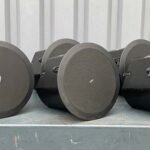In automotive engineering, flywheels and flexplates are crucial components that facilitate power transmission between the engine and the transmission system. While they serve similar purposes, their applications differ based on the type of transmission—manual or automatic.
Flywheel: Function and Application
A flywheel is a heavy, circular metal disc attached to the engine’s crankshaft in vehicles equipped with manual transmissions. Its primary functions include:
- Storing Rotational Energy: The flywheel maintains engine momentum during non-power strokes, ensuring smooth operation.
- Facilitating Clutch Engagement: It provides a friction surface for the clutch disc, enabling the transmission of power from the engine to the drivetrain.
- Assisting Engine Start: The flywheel’s toothed ring gear engages with the starter motor to crank the engine.
By stabilizing engine speed and reducing vibrations, the flywheel contributes to a smoother driving experience.
Flexplate: Function and Application
In contrast, a flexplate is a thinner, lighter metal disc found in vehicles with automatic transmissions. Its key roles are:
- Connecting Engine to Torque Converter: The flexplate links the engine’s crankshaft to the torque converter, facilitating power transfer to the transmission.
- Assisting Engine Start: Similar to the flywheel, the flexplate has a ring gear that engages with the starter motor to initiate engine operation.
The flexplate’s design accommodates slight flexing to absorb engine vibrations and torque converter movements, enhancing the durability of the drivetrain components.
Key Differences Between Flywheel and Flexplate
- Transmission Type: Flywheels are used in manual transmissions, while flexplates are found in automatic transmissions.
- Structure and Weight: Flywheels are heavier and thicker to store more energy; flexplates are lighter and thinner, designed to connect the engine to the torque converter.
- Functionality: Flywheels provide a friction surface for clutch engagement; flexplates connect the engine to the torque converter without a clutch interface.
Common Signs of Flywheel or Flexplate Issues
- Unusual Noises: Grinding or knocking sounds may indicate damage or wear.
- Starting Problems: Difficulty starting the engine can result from issues with the ring gear.
- Vibrations: Excessive vibrations during operation may signal imbalance or damage.
- Clutch or Transmission Slippage: In manual transmissions, a faulty flywheel can cause clutch slippage; in automatics, a damaged flexplate can lead to transmission slippage.
FAQ
- What is the primary function of a flywheel in a vehicle? A flywheel stores rotational energy, provides a friction surface for clutch engagement, and assists in starting the engine.
- How does a flexplate differ from a flywheel? A flexplate is used in automatic transmissions to connect the engine’s crankshaft to the torque converter, whereas a flywheel is used in manual transmissions to interface with the clutch assembly.
- What are common symptoms of a failing flywheel or flexplate? Symptoms include unusual noises, starting difficulties, excessive vibrations, and clutch or transmission slippage.
- Can a damaged flexplate affect engine starting? Yes, a damaged flexplate can impair the engagement between the starter motor and the ring gear, leading to starting issues.
- Is it safe to drive with a faulty flywheel or flexplate? Driving with a damaged flywheel or flexplate is not recommended, as it can lead to further mechanical failures and compromise vehicle safety.
Understanding the distinct roles of flywheels and flexplates is essential for proper vehicle maintenance and diagnosing drivetrain issues. Regular inspections and timely repairs can prevent potential failures and ensure a smooth driving experience.










